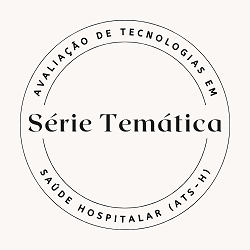Rinse-free bathing in bedridden patients: a systematic review on the efficacy and safety of the procedure
Série temática: Avaliação de Tecnologias em Saúde Hospitalar (ATS-H)
DOI:
https://doi.org/10.34019/1982-8047.2023.v49.42912Keywords:
Baths, Patient care, Personal hygiene products, Systematic reviewAbstract
Introduction: Rinse-free bathing is being used in some health institutions to replace conventional bed bathing, however, there is insufficient evidence regarding the effectiveness and safety of this procedure. Objective: to evaluate the effectiveness and safety of rinse-free baths in adult and old patients who require bed care. Materials and Methods: a systematic review was carried out, using the PRISMA statement as a guide. Three researchers independently, and consensually carried out the data selection and extraction phases. The inclusion criteria were: Randomized Controlled Clinical Trials (RCT) or quasi-experimental studies (QES) that evaluated the safety and efficacy outcomes of using a rinse-free bath. The search took place in the PubMed, COCHRANE, Web of Science and SCOPUS databases. The terms used in the searches were "Baths", "Patient Assistance", "personal hygiene products". Finally, the risk of bias of the studies was assessed using the ROB2 and Robins-I tools. Results: Four RCT and two QES studies were included. Three were classified as high risk of bias or some concerns. Two articles evaluated skin colonization, and one study evaluated skin integrity. There was a reduction in microbiota, and skin lesions in the rinse-free bath group. Most studies (three) didn’t show difference in cost between a no-rinse bath and a dry bath, however, there was less working time for nursing professionals. Conclusion: the use of a rinse-free bath proved to be effective in reducing skin microbiota, reducing the costs of nursing hours, and increasing satisfaction for patients, and professionals. As for safety, a study showed that rinsing baths were in favor of conventional baths. It is necessary to interpret the results with caution, given the methodological quality of some of the studies analyzed.
Downloads
References
Costa ALJC, Eugenio SCF. Cuidados de enfermagem [Internet]. Porto Alegre: Grupo A; 2014 [citado em 2023 abr 7]. Disponível em: https://integrada.minhabiblioteca.com.br/#/books/9788582710753/.
Paulela DC, Bocchi SC, Mondelli AL, Martin LC, Sobrinho AR. Eficácia do banho no leito descartável na carga microbiana: ensaio clínico. Acta Paul Enferm. 2018; 31(1):7-16. doi: 10.1590/1982-0194201800003
Paulela DC, Mondelli AL, Bocchi SCM, Nunes HR de C. Positividade de culturas por modalidades de banho no leito hospitalar: estudo ecológico. Acta Paul Enferm. 2022; 35:eAPE0167. doi: 10.37689/acta-ape/2022AO00167
Larson EL, Ciliberti T, Chantler C, Abraham J, Lazaro EM et al. Comparison of traditional and disposable bed baths in critically ill patients. Am J Crit Care. 2004; 13(3):235-41. Doi: 10.1111/jocn.15610
Johnson D, Lineweaver L, Maze LM. Patients' bath basins as potential sources of infection: a multicenter sampling study. Am J Crit Care. 2009; 18(1):31-8. doi: 10.4037/ajcc2009968.
Marchaim D, Taylor AR, Hayakawa K, Bheemreddy S, Sunkara B et al. Hospital bath basins are frequently contaminated with multidrug-resistant human pathogens. Am J Infect Control. 2012; 40(6):562-4. doi: 10.1016/j.ajic.2011.07.014
Bryant RA, Rolstad BS. Examining threats to skin integrity. Ostomy Wound Manage. 2001; 47(6):18-27.
Walker J, Moore G. Pseudomonas aeruginosa in hospital water systems: biofilms, guidelines, and practicalities. J Hosp Infect. 2015; 89(4):324-7. doi: 10.1016/j.jhin.2014.11.019.
Veje PL, Primdahl J, Chen M, Jensen CS, Sørensen J. Costs of bed baths: a scoping review. Nursing Economic. 2020; 38(4):194-202.
Sodhi J, Rao S, Subramaniam R, Lodha R, Sharma DK. Transition to bath wipes a better, hygienic and an infection free method for bathing of patients in critical care units. International Journal of Health Systems and Implementation Research. 2020; 4(3):43-4.
Gopalakrishnan S, Ganeshkumar P. Systematic reviews and meta-analysis: understanding the best evidence in primary healthcare. J Family Med Prim Care. 2013; 2(1):9-14. doi: 10.4103/2249-4863.109934.
Page MJ, McKenzie JE, Bossuyt PM, Boutron I, Hoffmann TC et al. A declaração PRISMA 2020: diretriz atualizada para relatar revisões sistemáticas. Epidemiol Serv Saúde. 31(2):e2022107. doi: 10.1590/s1679-49742022000200033
Uman LS. Systematic reviews and meta-analyses. J Can Acad Child Adolesc Psychiatry. 2011;20(1):57-9.
Sterne JAC, Savović J, Page MJ, Elbers RG, Blencowe NS et al. RoB 2: a revised tool for assessing risk of bias in randomized trials. BMJ. 2019; 366:1-8. doi: 10.1136/bmj.l4898
Sterne JA, Hernán MA, Reeves BC, Savović J, Berkman ND et al. ROBINS-I: a tool for assessing risk of bias in non-randomized studies of interventions. BMJ. 2016; 355:i4919. doi: 10.1136/bmj.i4919
Toledo LV, Salgado PO, Boscarol GT, Januário CF, Brinati LM, Ercole FF. Efeitos oxi-hemodinâmicos de diferentes banhos no leito: ensaio clínico randomizado cruzado. Acta Paul Enferm. 2022; 35:eAPE02116. doi: 10.37689/acta-ape/2022AO021166
Nøddeskou LH, Hemmingsen LE, Hørdam B. Elderly patients' and nurses' assessment of traditional bed bath compared to prepacked single units: randomized controlled trial. Scand J Caring Sci. 2015; 29(2):347-52. doi: 10.1111/scs.12170
Schoonhoven L, van Gaal BG, Teerenstra S, Adang E, van der Vleuten C, van Achterberg T. Cost-consequence analysis of "washing without water" for nursing home residents: a cluster randomized trial. Int J Nurs Stud. 2015; 52(1):112-20. doi: 10.1016/j.ijnurstu.2014.08.001
Hancock I, Bowman A, Prater D. 'The day of the soft towel?': comparison of the current bed-bathing method with the soft towel bed-bathing method. Int J Nurs Pract. 2000; 6(4):207-13. doi: 10.1046/j.1440-172x.2000.00222.x
Groven FM, Zwakhalen SM, Odekerken-Schröder G, Joosten EJ, Hamers JP. How does washing without water perform compared to the traditional bed bath: a systematic review. BMC Geriatr. 2017; 17(1):31. doi: 10.1186/s12877-017-0425-4
Nicolussi AC, Barichello E, Oliveira KF, Stacciarini TG. Eficácia e segurança do banho sem enxágue: parecer técnico científico. Uberaba: Núcleo de Avaliação de Tecnologia em Saúde do HC-UFTM; 2023.

Downloads
Published
How to Cite
Issue
Section
License
Copyright (c) 2024 Adriana Cristina Nicolussi, Elizabeth Barichello, Karoline Faria de Oliveira, Valter Paulo Neves Miranda, Thaís Santos Guerra Stacciarini, Saulo Pereira da Costa

This work is licensed under a Creative Commons Attribution 4.0 International License.
Cessão de Primeira Publicação à HU Revista
Os autores mantém todos os direitos autorais sobre a publicação, sem restrições, e concedem à HU Revista o direito de primeira publicação, com o trabalho licenciado sob a Licença Creative Commons Attribution que permite o compartilhamento irrestrito do trabalho, com reconhecimento da autoria e crédito pela citação de publicação inicial nesta revista, referenciando inclusive seu DOI.








